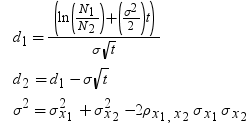MARGRCLPRC Function
Calculates call prices for European options on stocks, based on the Margrabe model.
| Category: | Financial |
| Returned data type: | DOUBLE |
Syntax
Arguments
X1
is a nonmissing, positive value that specifies the price of the first asset.
| Requirement | Specify X1 and X2 in the same units. |
| Data type | DOUBLE |
t
is a nonmissing value that specifies the time to expiration, in years.
| Data type | DOUBLE |
X2
is a nonmissing, positive value that specifies the price of the second asset.
| Requirement | Specify X2 and X1 in the same units. |
| Data type | DOUBLE |
sigma1
is a nonmissing, positive fraction that specifies the volatility of the first asset.
| Data type | DOUBLE |
sigma2
is a nonmissing, positive fraction that specifies the volatility of the second asset.
| Data type | DOUBLE |
rho12
specifies the correlation
between the first and second assets,  .
.
| Range | between –1 and 1 |
| Data type | DOUBLE |







